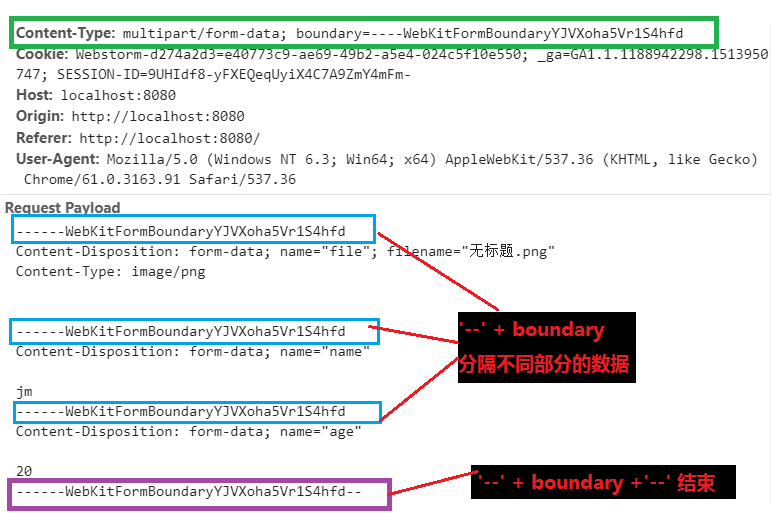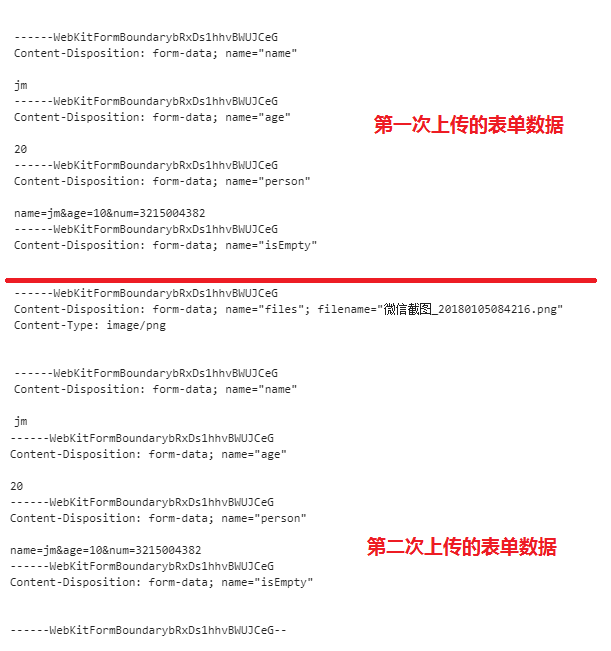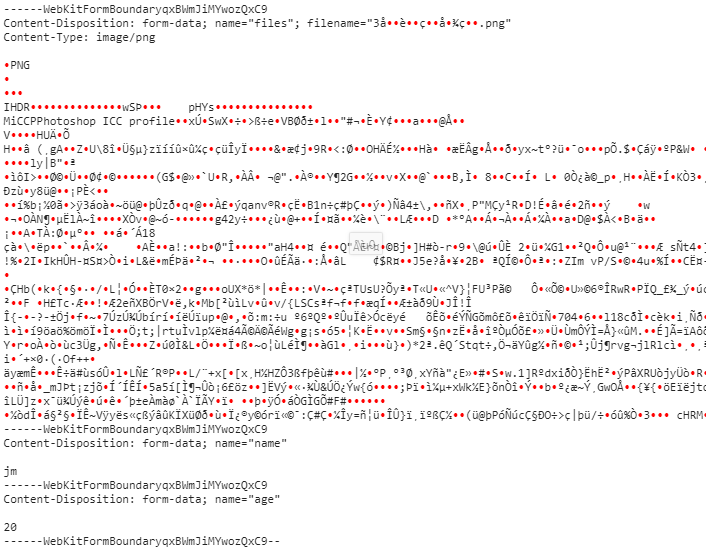一、表单数据的常用类型
1.1 form-data
------WebKitFormBoundary7A3ic8cRgGi1LkSv
Content-Disposition: form-data; name="name"
admin
------WebKitFormBoundary7A3ic8cRgGi1LkSv
Content-Disposition: form-data; name="password"
e10adc3949ba59abbe56e057f20f883e
------WebKitFormBoundary7A3ic8cRgGi1LkSv--
1.2 x-www-form-urlencoded
name=admin&password=e10adc3949ba59abbe56e057f20f883e
1.3 json
{
"name": "admin",
"password": "e10adc3949ba59abbe56e057f20f883e"
}
二、处理类型为multipart/form-data的表单数据
2.1 理解报文

- 1、
Content-Type:multipart/form-data; boundary=----WebKitFormBoundaryYJVXoha5Vr1S4hfd:
- 这行指出这个请求是“
multipart/form-data”格式的,且“boundary”是 “----WebKitFormBoundaryYJVXoha5Vr1S4hfd”这个字符串。
- 2、看到了
Request Payload里,不难发现:多个“-” + “boundary”是用来隔开表单中不同部分的数据的。
- 3、
boundary一般由系统随机产生,每部分的数据开头都是由--+boundary开始,由--+boundary+--结束
- 4、紧接着
boundary的是该部分数据的描述【可参考rfc1867】
- 简化之后的基本格式如下:
分隔符(指 '--' + boundary)
Content-Disposition: xxx; name="表单字段中的name值"; filename="文件名(单后缀)"
Content-Type: MIME类型
空行
文件二进制数据
分隔符(指 '--' + boundary)
...
结束符(指 '--' + boundary + '--')
Content-Disposition:内容类型
The original local file name may be supplied as well, either as a
'filename' parameter either of the 'content-disposition: form-data'
header or in the case of multiple files in a 'content-disposition:
file' header of the subpart. The client application should make best
effort to supply the file name; if the file name of the client's
operating system is not in US-ASCII, the file name might be
approximated or encoded using the method of RFC 1522. This is a
convenience for those cases where, for example, the uploaded files
might contain references to each other, e.g., a TeX file and its .sty
auxiliary style description.
Content-Disposition: form-data;:表明内容类型为表单数据name:该field的name为form表单中的字段中的name属性值filename: 文件后缀,该field为文件时才会有Content-Type: 文件MIME类型,也是field为文件时才会有- 分隔符:都是多个’
-’ + 一串随机字符串,结尾在此基础上多了个--而已。
- 例:
------WebKitFormBoundaryYJVXoha5Vr1S4hfd,这是Chrome浏览器;---------------------------325313178830032,这是火狐浏览器- 从例子可看出:每次发送过得
form-data中都不同,但是同一个请求主体中的分隔符都是相同的,只用于分隔不同field的数据- 换行:
http协议中,统一用\r\n表示
2.2 注意事项
- 1、如果用
formData = new FormData()提交表单数据,表单数据是会累积的,如下图:

- 2、还需知道的一点是,看下图
- 红色框框的就是传给后端的一个空字符串的字段,即
''(里面连一个空格都没有),其由buffer数据转化为字符串就变成了\r\n\r\n\r\n(是3个\r\n),中间是没有任何数据- 黄色下划线下的就是非空数据的字段

2.3 后端处理
- 后端接收到的是
Buffer数据类型,现在将Buffer数据转化成utf8格式的字符串,如下:

- 从图中可以发现:每一个表单数据都是以
---boundary开始和结尾【这就是获取每一个表单数据的关键点】
- 1、先获取数据
/**
* 获取数据
*/
getData () {
let req = this.req
let arr = []
req.on('data', chunk => {
// 这里将传来的buffer数据push到数组是因为:
// 如果传来的数据过大,那么所传的数据是不可能一次性传完的,可能会一段一段地传
// 为了获取完整的数据,需要将正一段段buffer放到一个数组里
arr.push(chunk)
})
// 接收数据完毕,才处理arr数组里的buffer数据
req.on('end', () => {
if (arr.length === 0) {
return
}
// 将多个buffer对象结合为一个buffer对象
this.bufferData = Buffer.concat(arr)
// 将buffer对象转化为utf8格式的字符串
this.str = this.bufferData.toString()
// 获取文件或字段数据
this.getFilesOrFieldsData()
})
}
- 将传来的
buffer数据push到一个数组内是因为如果传来的数据过大,那么所传的数据是不可能一次性传完的,可能会一段一段地传,为了获取完整的数据,需要将正一段段buffer放到一个数组里
- 2、获取每个字段
/**
* 获取每个字段
*/
getEachField () {
// 通过\r\n分隔,数组中第一个元素肯定是分隔符,即boundary
const boundary = this.str.split('\r\n')[0]
const boundaryBuffer = new Buffer(boundary)
const boundaryBufferLength = boundaryBuffer.length
// 存放boundary位置的数组
let indexData = []
// 存放每个字段的buffer数据的数组
let bufferDatas = []
// boundary的位置
let boundaryIndex = this.bufferData.indexOf(boundaryBuffer, 0)
// 以boundary为分界,获取一头一尾的index
// 转化为字符串为 ----boundary xxx数据\r\n
// 此时结尾的 \r\n 不足以作为结束标识
while (boundaryIndex > -1) {
indexData.push(boundaryIndex)
boundaryIndex = this.bufferData.indexOf(boundaryBuffer, boundaryIndex + 1)
}
// 让每个表单数据有完整的分隔点,所以每个位置(除了第一个位置外)都加上 boundaryBufferLength
// 转化成字符串就是 ----boundary xxx数据 ---boundary 或者为 \r\n xxx数据 ---boundary
// 结尾的---boundary必不可少
indexData = indexData.map((item, i) => {
return i === 0 ? item : item + boundaryBufferLength
})
const indexDataLength = indexData.length
// 获取每一个表单的buffer数据,并存进数组里【这里需要少一次循环】
for (let i = 0; i < indexDataLength - 1; i++) {
bufferDatas.push(this.bufferData.slice(indexData[i], indexData[i + 1]))
}
return bufferDatas
}
- 思路: 1、通过
\r\n分隔,获取数组中第一个元素【分隔符,即boundary】,并获取其对应的buffer,以及buffer长度 2、以boundary为分界,获取一头一尾的index,【一头一尾是指---boundary】,一开始只是单纯indexOf(boundaryBuffer),是无法获取到那一尾---boundary, 只是获取到了\r\n,因此在原来的基础上,每个位置(除了第一个位置外)都加上boundaryBufferLength3、通过 标志数组indexData,就可以获取每个字段的相应buffer数据
- 比如:
indexData = [0, 90, 100],那么bufferData.slice(0, 90)就是第一个表单buffer数据,bufferData.slice(90, 100)就是第二个表单buffer数据- 这也说明了为什么要少一次循环
- 获取文件或字段数据
/**
* 获取文件或字段数据
*/
getFilesOrFieldsData () {
const bufferDatas = this.getEachField()
// 每个字段数据的开始标识
const startBuf = new Buffer('\r\n\r\n')
// 每个字段数据的结束标识
const endBuf = new Buffer('\r\n----')
for (let eachFileds of bufferDatas) {
const item = eachFileds.toString()
// 4 代表的是 `\r\n\r\n`的长度
const startIndex = eachFileds.indexOf(startBuf) + 4
const endIndex = eachFileds.indexOf(endBuf)
// 字段名
const name = item.match(/\sname="(.*?)"/)[1]
// 文件名
const fileName = item.indexOf('filename') > -1 ? item.match(/\sfilename="(.*?)"/)[1] : ''
// 处理文件
if (fileName) {
const type = item.indexOf('Content-Type') > -1 ? item.match(/\r\nContent-Type:\s(.*?)\r\n/)[1] : ''
this.files[name] = {
name: fileName,
type: type,
data: eachFileds.slice(startIndex, endIndex)
}
}
// 处理字段
else {
this.fields[name] = eachFileds.slice(startIndex, endIndex).toString() || ''
}
}
this.cb(this.fields, this.files)
}
- 这个思路也蛮简单的,需分两类处理:
- 第一类是
buffer数据:由于文件是要保存二进制数据的,因此为了方便,一头一尾的标识(startBuf和endBuf)我都用了buffer数据去处理,并且一头一尾的位置(startIndex和endIndex)也是通过buffer数据去处理- 第二类是字符串数据:文件的头信息 与 字段的头信息、数据都需要把
buffer数据转化成字符串才能处理
2.4 如何使用及demo
new formidable(req, (fields, files) => {
// fields 是表单字段对象
// files 是文件对象
})
